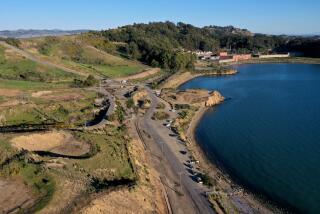Conservancy OKs Revised Temescal Plan : Agency Hopes New Park Design Will Settle Dispute With Church
- Share via
Attempting to sidestep a dispute with a Presbyterian church group over road access, the Santa Monica Mountains Conservancy has approved a new design for its Temescal Gateway Park in Pacific Palisades.
Construction could begin as soon as next winter on the 20-acre park, intended as a entryway to the western side of Topanga State Park, said Joseph Edmiston, the conservancy’s executive director. The opening is planned for July, 1989, by the conservancy, a state agency that purchases land for park use.
Edmiston said the new design is intended to prevent the project from being further delayed by a disagreement with the Presbyterian Synod of Southern California and Hawaii, which owns a 147-acre conference center in Temescal Canyon next to the conservancy’s land.
The synod, a governing body for 285 churches, is seeking city approval to expand its center to accommodate 500 overnight guests. It shares with the conservancy a road entering the area off Sunset Boulevard. A previous agreement calling for the two parties to share the cost of improving and widening the road to serve both developments fell through last spring.
Relocated Parking Spaces
The conservancy then redesigned its plans, moving its parking spaces closer to Sunset Boulevard so that it would not have to use much of the road, which crosses both properties.
Approved by the conservancy’s board Aug. 2, the plans call for constructing a ranger station and 55 parking spaces and for landscaping the park, Edmiston said.
The conservancy board decided not to resurface the existing road in hopes that it can be removed if the synod builds a new road for the conference center, Edmiston said. “We don’t want to build something that we’ll have to tear out in a couple of years,” he said.
Edmiston said he hoped that the two organizations could cooperate despite the way in which their agreement about the road unraveled. While the conservancy believed that church officials had agreed to share the cost of a 20-foot-wide road, the synod maintained that the agreement did not specify a width.
Insensitivity Alleged
Synod consultant Ann Krueger said the church could not agree on a specific width until the city decides how wide a road is necessary to serve the development. By redesigning its park to avoid the road issue, the conservancy has been insensitive to the synod’s need to construct a road wide enough to meet whatever the city requires, she said.
“My sense was the conservancy was proceeding with the plan adopted by the board and the synod’s concerns were not an issue,” Krueger said.
Krueger also charged that the conservancy is reneging on an obligation it assumed when it purchased the land for Temescal Gateway Park from the Los Angeles Unified School District in 1982. The land had been acquired by the school district from the synod with a promise--never fulfilled--that the district would build a new road and sewer system for both properties, she said.
Krueger said the synod has no comment on how it might try to enforce the old agreement.
Edmiston said the state attorney general’s office told the conservancy that the synod’s claim is “wholly without merit.”
The synod is facing opposition to its conference center expansion from neighborhood groups that fear development will bring traffic and noise to the canyon.
“The development will essentially ruin the canyon because it takes up that area that is now so beautiful and turns it into buildings and asphalt,” said Diane August of Friends of Temescal Canyon.
The synod’s conference center, which began in the 1920s as a place where Methodists held summer religious gatherings known as Chautauquas, now accommodates nonprofit organizations in a 135-bed facility.
The synod’s plans call for the addition of 70,100 square feet of facilities, including eight new lodges, a new dining hall, an administrative building and a staff house. Krueger said the expansion, to be built in phases over 10 years, is necessary so the center can be host to large church gatherings.
More to Read
Sign up for Essential California
The most important California stories and recommendations in your inbox every morning.
You may occasionally receive promotional content from the Los Angeles Times.













